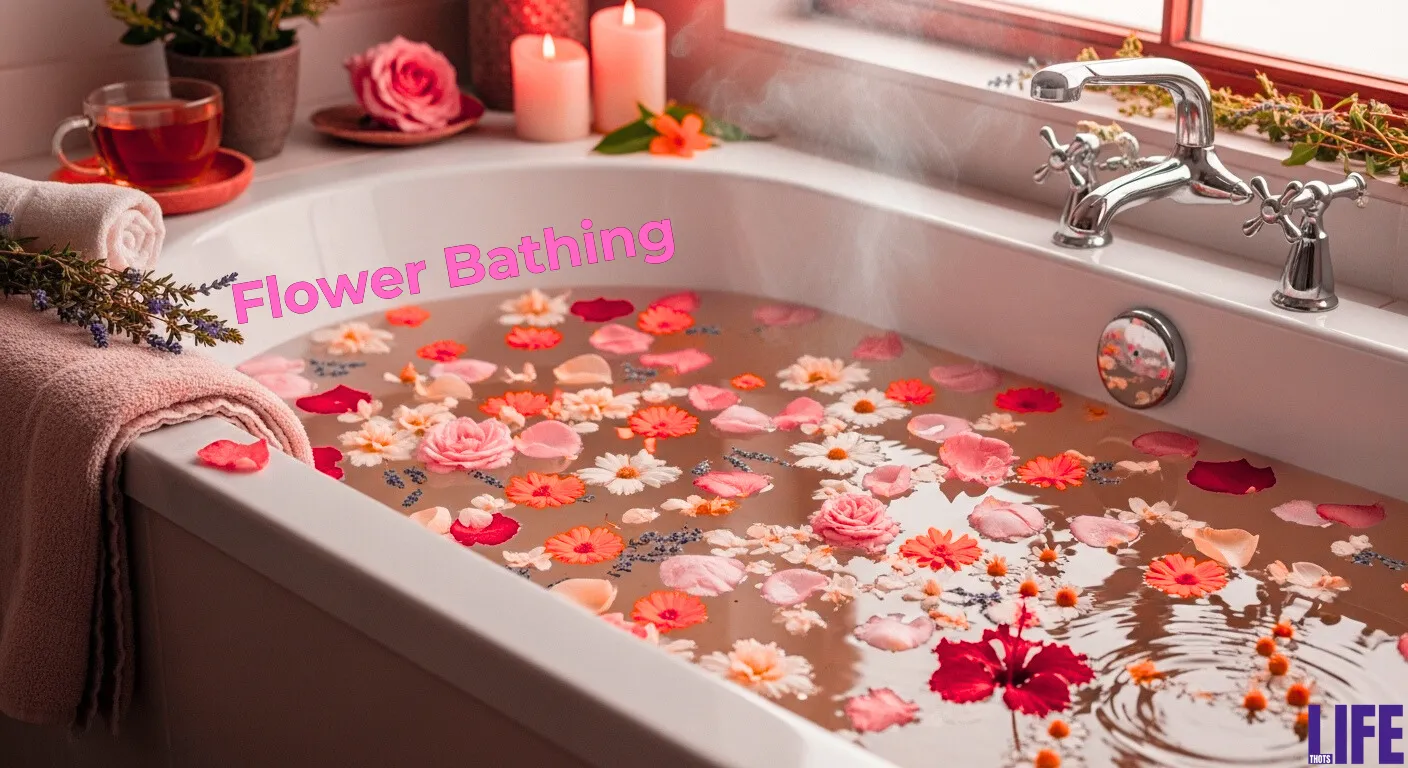Blog
Flower Bathing: Benefits, Steps, and Flower Choices

Imagine stepping into a warm bath filled with floating petals rose, jasmine, and lavender dancing on the surface as their scents calm your mind. This is flower bathing, an ancient ritual that’s finding new life in today’s wellness world. More than just a pretty Instagram photo, flower bathing is a mindful self-care practice that relaxes the body, nourishes the skin, and uplifts the spirit.
In this complete guide, you’ll learn everything about flower bathing its benefits, simple steps to create your own at home, and the best flower choices for your mood and skin type. We’ll also explore how this post goes beyond the information found on popular wellness blogs like Yoga Journal, FloraQueen, and Nectar & Bloom by providing practical details, cultural insights, and modern science-backed explanations.
What Is Flower Bathing?
Flower bathing is a ritual where you soak your body in warm water infused with fresh or dried flower petals, herbs, and sometimes essential oils or salts. It’s believed to cleanse not only the body but also the mind and soul.
Historically, this practice traces back to different cultures:
- In Indonesia and Malaysia, people perform the mandi bunga or “flower bath” before significant life events to clear negative energy.
- In Japan, hanami (flower appreciation) extends into bathing traditions, celebrating the healing beauty of blossoms.
- In ancient Rome and Greece, flower-infused baths were seen as symbols of luxury and vitality.
Today, we understand that it’s not magic it’s mindful self-care through sensory therapy. The combination of warm water, natural fragrance, color, and tactile sensation helps trigger relaxation responses in the brain, much like aromatherapy or meditation.
Why This Guide Is Different From Others
While competitor blogs like Yoga Journal focus mainly on the spiritual side of flower bathing, and FloraQueen touches on general benefits, this guide dives deeper with:
- Detailed, research-informed explanations of how and why it works.
- A clear, realistic at-home routine (even if you don’t have a bathtub).
- A complete flower benefits table for targeted results (skin care, stress, energy, etc.).
- Practical safety and customization tips missing from most online guides.
Let’s move on to why this practice is worth trying.
Your Complete Flower Bathing Journey
From ancient ritual to modern wellness practice
Deep Relaxation & Stress Relief
Warm water dilates blood vessels while aromatic petals engage your senses, lowering cortisol and releasing endorphins. It’s nature’s antidepressant, minus the side effects.
Skin Healing & Hydration
Natural oils and antioxidants from flowers nourish your skin. Calendula reduces redness, rose petals hydrate, and hibiscus supports a youthful glow.
Aromatherapy & Mood Enhancement
Each flower affects mood uniquely. Jasmine lifts and energizes, while lavender and chamomile soothe anxiety with natural aromatherapy effects.
Spiritual & Emotional Cleansing
Immersing yourself in natural beauty helps release emotional heaviness. The act itself reconnects you to your inner calm and peace.
Circulation & Detox Support
Warm water boosts circulation, delivering oxygen to your skin. Add Epsom salt or rosemary oil to enhance detox and muscle relaxation.
Pro Tip for the Perfect Flower Bath 🌼
Always use organic, pesticide-free flowers. Avoid dyed petals — they may stain your tub or skin. For an eco-friendly touch, compost your petals afterward instead of tossing them away.
Step-by-Step Guide to Flower Bathing
Creating your own flower bath doesn’t require a luxury spa — just a bit of preparation and intention.
Set the Scene
Clean your tub or basin first. Light a candle or play calming music. Turn off harsh lights — soft or natural lighting enhances the peaceful mood.
Why it matters: A clutter-free, calm space helps your mind relax and signals your body it’s time to rest.
Choose Your Water Temperature
Use warm water (around 37–39°C) — comfortably warm, not hot. Too much heat can dehydrate your skin and make you dizzy.
Why it matters: Warmth improves circulation and helps open pores so your skin can better absorb nutrients from the petals.
Add Base Ingredients
Before the flowers, pour in your optional base ingredients:
- ½ cup Epsom salt (muscle relaxation)
- 1 teaspoon almond or coconut oil (hydration)
- 2–3 drops of essential oil (optional for scent)
Why it matters: The base enhances skin nourishment and amplifies relaxation.
Add Your Flower Petals
Now, scatter your chosen petals on the water. You can mix multiple kinds or stick with one flower type for a signature scent. Gently stir the water to release their natural oils.
Tip: Use about 2 cups of petals for a standard bathtub.
Soak and Breathe
Step into the bath, close your eyes, and focus on your breathing. Stay in for 15–20 minutes. Feel the warmth, enjoy the scents, and let your thoughts drift away.
Why it matters: Mindful breathing and sensory focus calm the nervous system, improving the restorative effects.
Rinse and Moisturize
After soaking, rinse off lightly with clean water to remove any residue. Pat your skin dry and apply a moisturizer or body oil while your skin is still slightly damp.
Reflect and Hydrate
Finish your ritual by drinking water or herbal tea. You can journal a thought, intention, or affirmation — whatever suits your moment of calm.
Extra Tips for the Perfect Flower Bath
- Use a mesh strainer to remove petals afterward (saves your plumbing!).
- For small apartments, a large bowl or foot soak still provides relaxation.
- If you have allergies, test a small petal infusion on your arm before full use.
- Combine petals with lemon slices or cucumber for a spa-like detox boost.
- Keep dried flowers stored in an airtight jar they last up to six months.
Common Mistakes to Avoid
Even the most beautiful flower bath can go wrong if you skip these details:
- Don’t use artificially dyed petals they can stain your skin and tub.
- Don’t add too many essential oils 2–3 drops are enough.
- Don’t soak for over 30 minutes prolonged heat can cause dizziness.
- Don’t skip hydration drink water afterward to balance your body’s temperature.
Conclusion
Flower bathing isn’t just about beauty it’s about balance. It gives your body a break from tension and your mind a space to breathe. Whether you see it as a ritual therapy, or indulgence, it’s one of the simplest ways to reconnect with yourself and nature. With the right flowers, mindset, and setup, your bathroom can transform into a personal spa full of color, scent, and serenity. So next time you feel drained, skip the screen and take a flower bath instead because sometimes, healing is just a few petals away.
